| View previous topic :: View next topic |
| Author |
Message |
Josele

Joined: 10 Apr 2012
Posts: 410
Location: Tarifa, Spain



|
 Posted: Jun 13, 2020 09:25 Post subject: Habit restriction of garnets Posted: Jun 13, 2020 09:25 Post subject: Habit restriction of garnets |
|
|
Although they belong to the isometric system holohedral class (hexaoctahedral) and although they occur in a variety of rocks with diverse pressure and temperature conditions of formation, garnets habit is almost* exclusively rhombic-dodecahedral, trapezohedral (icositetrahedral) or a combination.
After reading some literature about garnets and raising the topic in Mindat ( https://www.mindat.org/mesg-516040.html ), at the moment I've been unable to find specific reasons explaining this restriction.
What prevents garnets from forming the rest of the polyhedrons of his crystalline class?
Maybe somebody can help?
*some exceptions as follow:
| Mineral: | Grossular |
| Locality: | | Vesper Peak, Sultan Basin, Sultan District, Snohomish County, Washington, USA |  |
|
| Dimensions: | Main crystal: 10 mm |
| Description: |
Garnet crystal with rhombic-dodecahedral habit modified by the cube
Image modified from © Jaimy Henman
(https://www.mindat.org/photo-596294.html) |
|
| Viewed: |
23791 Time(s) |
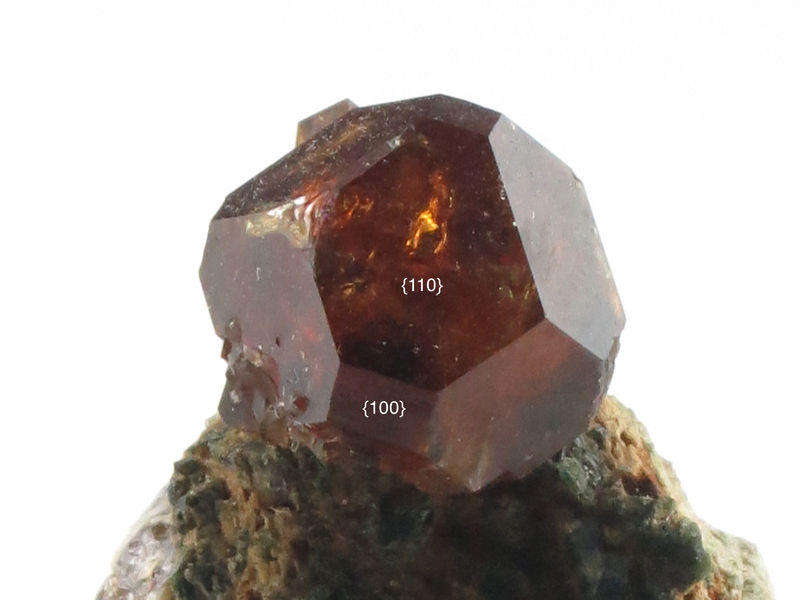
|
| Mineral: | Grossular (variety hibschite) |
| Locality: | | Acquasaliente Creek, Contrade Maglio-Pornaro, Munari Valley, Tretto, Schio, Vicenza Province, Veneto, Italy |  |
|
| Dimensions: | Largest crystal: 0.5 mm |
| Description: |
Hibschite usually crystallizes with octahedral habit.
Image modified from © Antonio Zordan (https://www.mindat.org/photo-557286.html) |
|
| Viewed: |
23855 Time(s) |
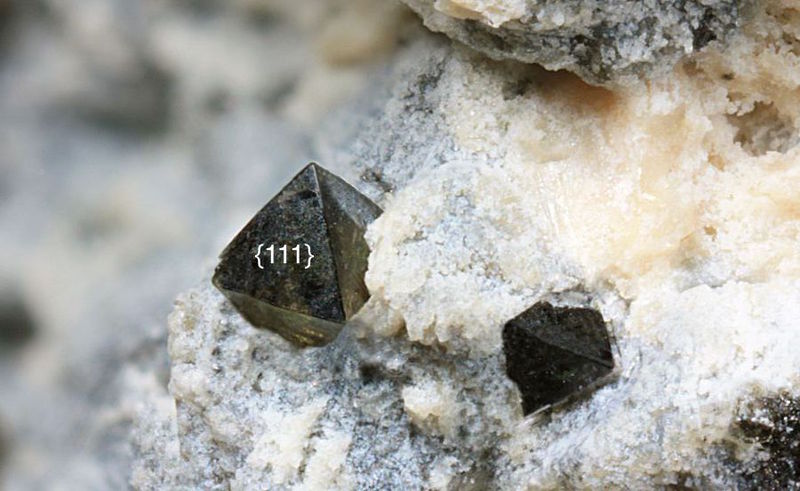
|
| Mineral: | Spessartine |
| Locality: | | Rock Run area, Potomac River, Montgomery County, Maryland, USA |  |
|
| Dimensions: | Crystal size: 0.5 mm |
| Description: |
A completely cubic garnet!
Image © - J. Nelson Cubic Garnets found in Maryland and Virginia streams, USA (http://mineralzine.chez.com/ancien/info4-4-b.htm) |
|
| Viewed: |
23773 Time(s) |
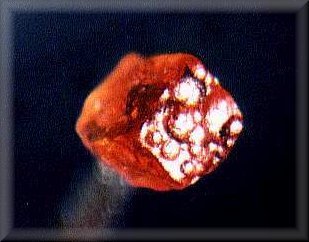
|
|
|
| Back to top |
|
 |
Pete Richards
Site Admin
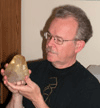
Joined: 29 Dec 2008
Posts: 843
Location: Northeast Ohio



|
 Posted: Jun 13, 2020 13:32 Post subject: Re: Habit restriction of garnets Posted: Jun 13, 2020 13:32 Post subject: Re: Habit restriction of garnets |
|
|
Josele, you always have great questions!
There are theories of crystal growth that account for this, but due to their complexity I'm only going to provide some generalities from them.
The Law of Bravais, simplified, says that the importance of a face on a crystal - its size and/or frequency of occurrence - is proportional to the density of atoms in that plane. This is sort of an atomic level explanation of the general geometric principle that faces that grow the slowest are the largest. It says that if faces contain lots of atoms, it takes longer to fill a layer of that face, so it grows more slowly.
The Law of Bravais is quite successful in predicting the morphology of many crystals, but there are notable failures, Garnet is one of them.
In 1937, J.D.H. Donnay and A. Harker published a paper A New Law of Crystal Morphology Extending the Law of Bravais. The extension was to take account of the effects of symmetry elements found in certain space groups called glide planes and screw axes. I won't try to repeat the argument. Suffice it to say that one of their examples is garnet, the structure of which contains a glide plane. With their new law, they predicted that forms on garnet should be the trapezohedron {211}, the dodecahedron {110}, the cube {100} and the hexoctahedron {321}, in that order. This result probably suggests the cube should be more important than what we observe, but it is a pretty good prediction, as such things go.
The paper was published by the American Mineralogist, and for Americans at least (which is what I am, so I don't know about others!), it can be downloaded free from their website http://www.minsocam.org/msa/ammin/toc/. It is a very important classical paper on the theory of crystal morphology, and I encourage those with the interest to look it up!
_________________
Collecting and studying crystals with interesting habits, twinning, and epitaxy |
|
| Back to top |
|
 |
SteveB
Joined: 12 Oct 2015
Posts: 238
Location: Canberra


|
 Posted: Jun 13, 2020 14:20 Post subject: Re: Habit restriction of garnets Posted: Jun 13, 2020 14:20 Post subject: Re: Habit restriction of garnets |
|
|
I’m out of my depth with that paper and the answer to the question. Browsing it, and my gut instinct about molecular representations I’m wondering if it would be correct to say the Law of Bravais is only the best approximation that is currently known? Like Newton’s efforts in physics still work today for reasonably accurate real world predictions and observations, Einstein improved on Newton which allows for better accuracy at different scales but still we don’t have definitive equations to describe physics in all instances. That is do we need a “chemistry Einstein” to improve on Bravais?
Thanks for that link too, a ton of information in that library
|
|
| Back to top |
|
 |
Pete Richards
Site Admin

Joined: 29 Dec 2008
Posts: 843
Location: Northeast Ohio



|
 Posted: Jun 13, 2020 15:16 Post subject: Re: Habit restriction of garnets Posted: Jun 13, 2020 15:16 Post subject: Re: Habit restriction of garnets |
|
|
That's a good question too, Steve!
For sure I don't know the full answer, the full theory, and I'm pretty sure no one does. What is now known as the Donnay-Harker Law is an improvement over the Bravais Law. But it does not really even get into chemsitry, it's basically just about how long it takes to put a bunch of marbles on a sheet of paper. Many other factors influence the shapes of crystals, and we know some from growing crystals ourselves, but many of the factors that influenced the shape of the quartz crystal you just found are no longer around to observe, so we try to make smart guesses rather than foolish ones.
Crystals don't grow in a vacuum - they grow in a medium of some sort - liquid, molten rock, solid rock, which provides the ions they need to grow, but also contains many other substances, and some of them may affect the shape of the crystal by adhering to certain faces and slowing down their growth rate. Temperature and pressure often play a role, as does the rate of growth, or the relative abundance of the negatively and positively charged ions feeding the crystal growth. We will never work it all out to the point that we can say why an already-existing crystal has exactly the shape it does. It's pretty exciting to be able to correctly "predict" that a garnet should be trapezohedral and/or dodecahedral, but I for one am not going to tangle my brain about why Josele's grossular from Vesper Peak has a cube face (as do mine). It's something about that place and time, it's neat to see, but who knows why? At least the cube is in short list of predicted forms. The theory does not predict an octahedral garnet like his hibschite at all, and octahedral faces on garnet are extremely rare otherwise.
_________________
Collecting and studying crystals with interesting habits, twinning, and epitaxy |
|
| Back to top |
|
 |
Josele

Joined: 10 Apr 2012
Posts: 410
Location: Tarifa, Spain



|
 Posted: Jun 13, 2020 17:18 Post subject: Re: Habit restriction of garnets Posted: Jun 13, 2020 17:18 Post subject: Re: Habit restriction of garnets |
|
|
Thank you Pete and Steve. Asking is always easier than answering. But often for the asker (me in this case!) the problem is understanding the smart responses.
This garnet issue has always puzzled me and I really much appreciate your clues to focus the matter, especially when there is not a clear and simple answer.
And thanks again for providing me reading for the next days.
To be continued...
|
|
| Back to top |
|
 |
SteveB
Joined: 12 Oct 2015
Posts: 238
Location: Canberra


|
 Posted: Jun 13, 2020 18:59 Post subject: Re: Habit restriction of garnets Posted: Jun 13, 2020 18:59 Post subject: Re: Habit restriction of garnets |
|
|
It’s interesting to consider. Its an area I’m very ignorant about, but my knowledge from other scientific disciplines sets me thinking along symmetries like chiral. Where the same molecular structure can form but as mirror image shapes of each other which cause a large difference in outcome. If i recall oranges and lemons share this somewhere (organic chemistry?) so the same molecule in left handed form produces a sweet fruit while right handed the same molecule results in bitter. Maybe its the chemical makeup where a certain element restricts and/or prefers certain molecular bonds with the corresponding structure angles.
As Pete pointed out crystals grow under varying and changing conditions. It may be worth looking into chemical compositions of various garnets and group by crystal formation. My gut tells me its a chemistry answer that needs to be looked for as the chemical elements can form many shapes but prefer certain stable forms requiring the least amount of energy to achieve for the conditions. I dont think I’ve seen rocks containing crystals of one mineral in differing forms or shapes (actually agate geodes could be considered) but as for garnets are there any good surveys of a single deposit where crystal shape is varied Or is it large geograhic distances to find variations? I think colour, clarity, and size are related to element saturation, temperature, pressure and time. I don’t think shape is primarily related to those factors or it’d be common to have rocks containing minerals for example that are half dodecahedral and half cubic as one single crystal. I’d be more inclined to think its related to the chemical makeup where the amount of certain element may be high enough to alter molecular shape while at lower amounts it may instead precipitate out .
Its not exactly something we can test at home like growing salt crystals on the window sill . It’s a siutation we can’t directly observe in nature to determine how the growth conditions some into play.
|
|
| Back to top |
|
 |
Bob Morgan
Joined: 18 Jan 2018
Posts: 251
Location: Savannah, Georgia



|
 Posted: Jun 13, 2020 22:06 Post subject: Re: Habit restriction of garnets Posted: Jun 13, 2020 22:06 Post subject: Re: Habit restriction of garnets |
|
|
There is another theoretical paper that models more closely the occurrences of faces of garnets. It is "Morphology of Garnets and Structure of F Slices Determined from a PBC Analysis" By P. Bennema that is in the Journal of Crystal Growth 62 (1983) 41-60. I do think we are getting closer to understanding the rarer faces with the Periodic Bond Chain (PBC) approach, particularly if relaxation of atoms at the surface is factored in that may produce bond chains that stabilize such faces.
Lots'a luck understanding it!
They did find that chemical composition of some garnets had an effect on the relative dominance between dodecahedral and trapezohedral faces.
There is another common garnet face that hasn't been mentioned, the hexoctahedral which usually appears as thin faces between dodecahedral and trapezohedral faces, most commonly on hessonites.
And Val 'd Ala in Italy also has cube faces similar to Vesper Peak
.
Then there are tetrahexahedral faces most noticeably on crystals from Inyo County, California, but also on some from Merilani, Tanzania and on rare occasions from Pakistan.
I have heard that some garnets from the Isle of Elba have small octahedral faces - very rare.
Finally, I know of two localities which have trisoctahedral faces. One is Black Lake, Quebec, Canada the other is Rudnyi, Kazahkstan. The latter has trisoctahedral pyramids between dodecahedral faces with a small central octahedral face in each.
I will try to produce photos of them if there is interest.
|
|
| Back to top |
|
 |
fena kuiperi
Joined: 06 Apr 2016
Posts: 18


|
 Posted: Jun 14, 2020 03:03 Post subject: Re: Habit restriction of garnets Posted: Jun 14, 2020 03:03 Post subject: Re: Habit restriction of garnets |
|
|
| I'm just an amateur, but very interested in crystal morphology, photo's would be very welcome!
|
|
| Back to top |
|
 |
Duncan Miller

Joined: 25 Apr 2009
Posts: 138
Location: South Africa



|
 Posted: Jun 14, 2020 04:10 Post subject: Re: Habit restriction of garnets Posted: Jun 14, 2020 04:10 Post subject: Re: Habit restriction of garnets |
|
|
This fairly recent paper isn't about garnets, but it has a potentially useful list of references and gives one some idea of the complexity of research in trying to understand crystal habits. It should be downloadable in its entirety.
http://www.sciencedirect.com/science/article/pii/S0960897416300158
(link normalized by FMF)
|
|
| Back to top |
|
 |
Roger Warin

Joined: 23 Jan 2013
Posts: 1232



|
 Posted: Jun 14, 2020 16:19 Post subject: Re: Habit restriction of garnets Posted: Jun 14, 2020 16:19 Post subject: Re: Habit restriction of garnets |
|
|
Hello,
The growth of the crystal is controlled in particular by the thermodynamic stability of the reticular planes, but it is also necessary to add to it the kinetics of the crystallization, very dependent on the conditions of temperature for example. This kinetics is also a function of the local concentration of ions which deposit on the crystal. This is where the difference in behavior between apex, edges, and planes comes in.
Relative to the cube, the octahedral and dodecahedral forms are the result of additions of units along directions of accelerated growth.
Of course, it can graft on competitions with other molecules or ions that can bind at the receptor site.
Roger Warin.
PS: temperature is an important factor. Thus, twins (an irregularity in the basic lattice) have a higher probability of appearance when the temperature is at the highest in the range allowed for a crystalline phase.
|
|
| Back to top |
|
 |
Bob Morgan
Joined: 18 Jan 2018
Posts: 251
Location: Savannah, Georgia



|
 Posted: Jun 14, 2020 21:00 Post subject: Re: Habit restriction of garnets Posted: Jun 14, 2020 21:00 Post subject: Re: Habit restriction of garnets |
|
|
Here are some photos of less common garnet faces.
| Mineral: | 'Garnet' |
| Dimensions: | 1.8 cm |
| Description: |
|
| Viewed: |
23485 Time(s) |
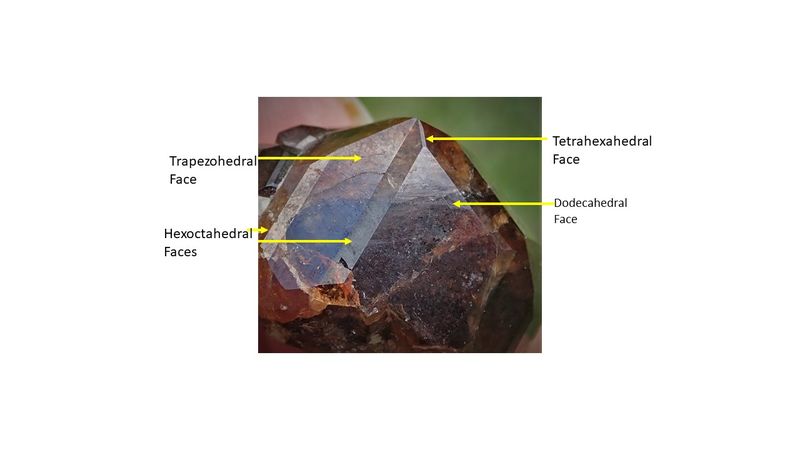
|
| Mineral: | 'Garnet' |
| Dimensions: | .8 cm |
| Description: |
|
| Viewed: |
23452 Time(s) |
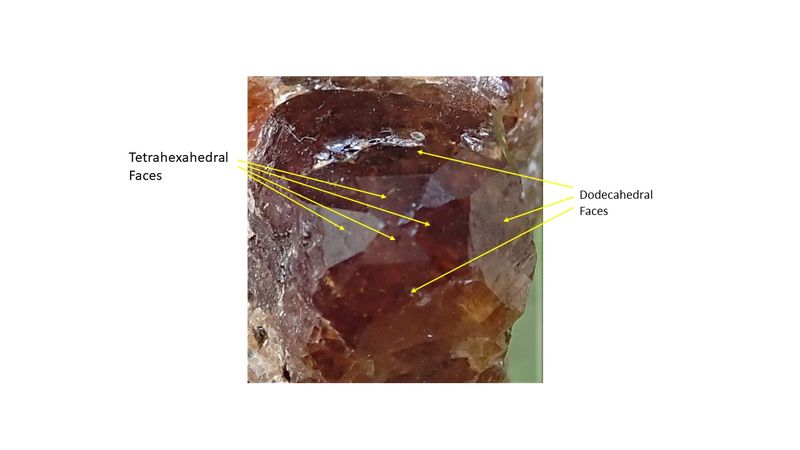
|
| Mineral: | 'Garnet' |
| Dimensions: | 1.7 cm |
| Description: |
| tetrahexahedral faces on both ends of a dodecahedral face bordered by hexoctahedral and trapezohedral bands |
|
| Viewed: |
23514 Time(s) |
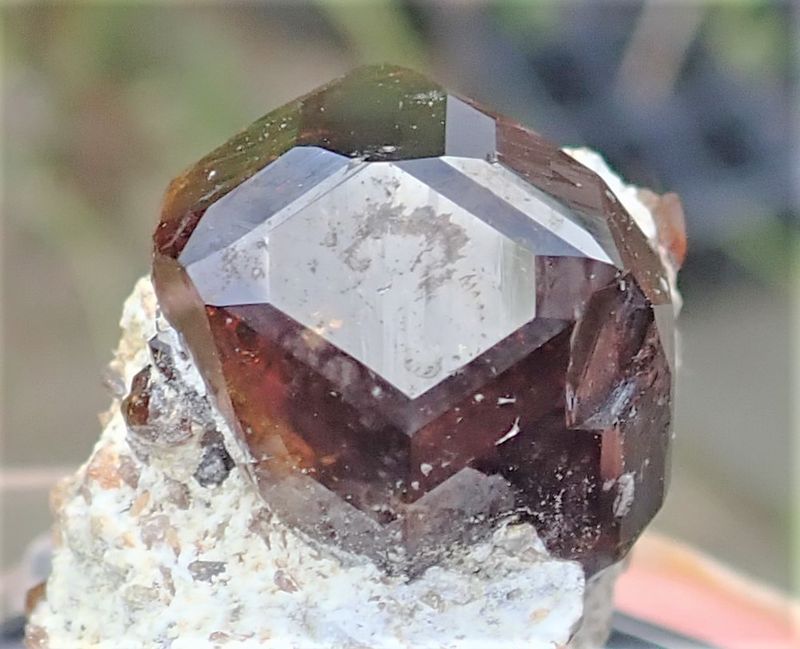
|
|
|
| Back to top |
|
 |
Bob Morgan
Joined: 18 Jan 2018
Posts: 251
Location: Savannah, Georgia



|
 Posted: Jun 14, 2020 22:09 Post subject: Re: Habit restriction of garnets Posted: Jun 14, 2020 22:09 Post subject: Re: Habit restriction of garnets |
|
|
More garnet faces
| Mineral: | 'Garnet' |
| Locality: | | Tubussis Farm 22, Karibib District, Erongo Region, Namibia |  |
|
| Dimensions: | 1 cm across |
| Description: |
| The main face is dodecahedral. On each end are thin tetrahexahedral faces. On the left corner of the dodecahederal face is tetrahexahedral face of a shallower tetrahexahedral form. |
|
| Viewed: |
23429 Time(s) |
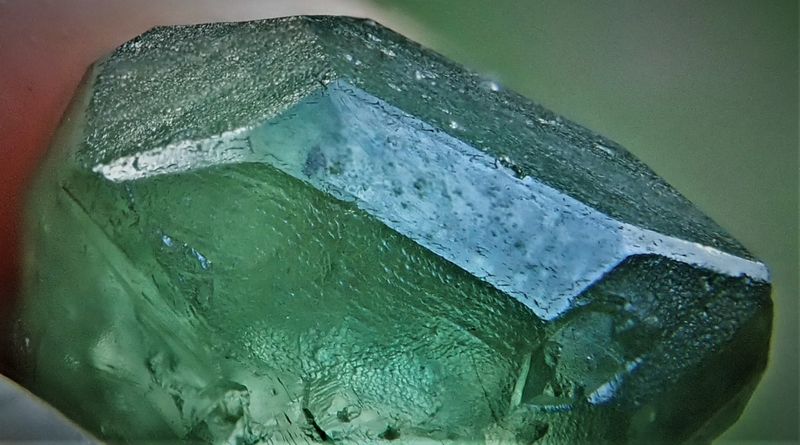
|
| Mineral: | 'Garnet' |
| Locality: | | Val d'Ala, Lanzo Valleys (Valli di Lanzo), Metropolitan City of Turin Province, Piedmont (Piemonte), Italy |  |
|
| Dimensions: | 0.8 cm |
| Description: |
| Dominantly trapezohederal with dodecahederal edges topped by a cube face |
|
| Viewed: |
23402 Time(s) |
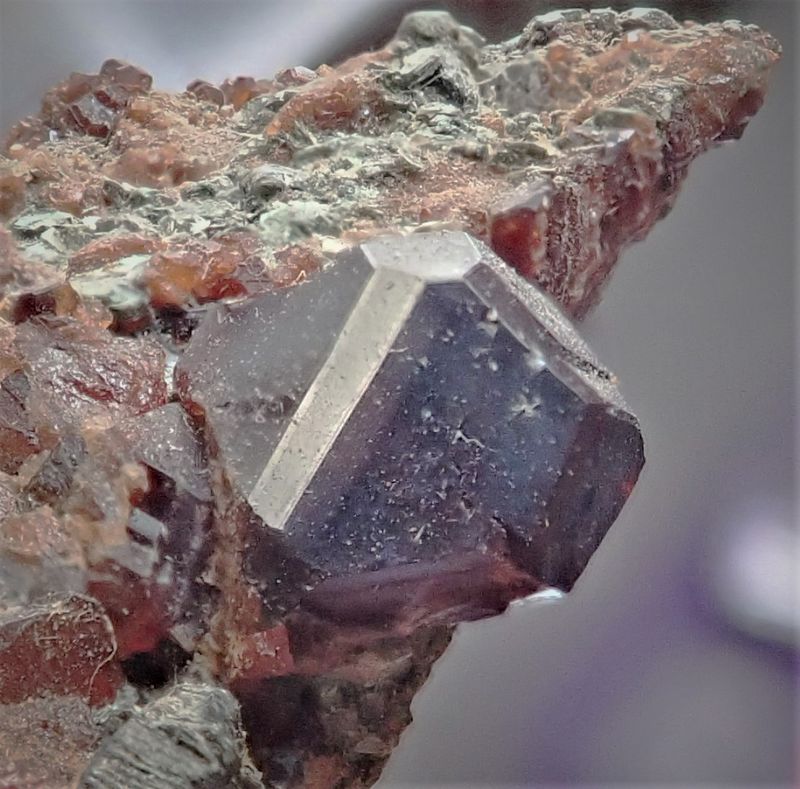
|
| Mineral: | 'Garnet' |
| Locality: | | Rudny Altai, Rudny, Kostanay Region, Kazakhstan |  |
|
| Dimensions: | 0.5 cm |
| Description: |
| A trisoctahederal pyramid nested between dodecahedral faces with a small triangular, octahederal top. |
|
| Viewed: |
23419 Time(s) |
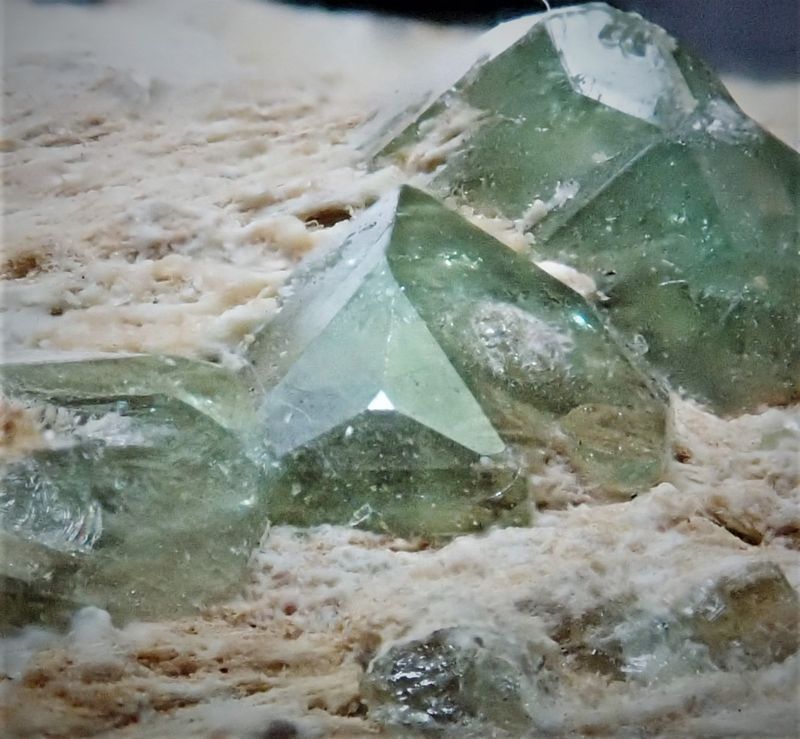
|
|
|
| Back to top |
|
 |
fena kuiperi
Joined: 06 Apr 2016
Posts: 18


|
 Posted: Jun 15, 2020 03:35 Post subject: Re: Habit restriction of garnets Posted: Jun 15, 2020 03:35 Post subject: Re: Habit restriction of garnets |
|
|
| Thanks a lot for these photo's, very special to see these faces, makes my day!
|
|
| Back to top |
|
 |
Sante Celiberti
Joined: 04 Oct 2019
Posts: 699
Location: Tuscany



|
 Posted: Jul 26, 2020 16:10 Post subject: Re: Habit restriction of garnets Posted: Jul 26, 2020 16:10 Post subject: Re: Habit restriction of garnets |
|
|
Hello.
Thanks to the information contained in this thread I was able today to purchase this small sample of Alpine grossular at the 52th mineral fair of Massa Marittima which will end at midnight.
Without this valuable information I would not have considered it.
Thank you all.
| Mineral: | Grossular (variety hessonite), Clinochlore |
| Locality: | | Faiallo Pass, Urbe, Savona Province, Liguria, Italy |  |
|
| Dimensions: | 48 x 36 mm |
| Description: |
| The main crystal, which measures 6 mm, shows a dominant cubic habit. |
|
| Viewed: |
21997 Time(s) |
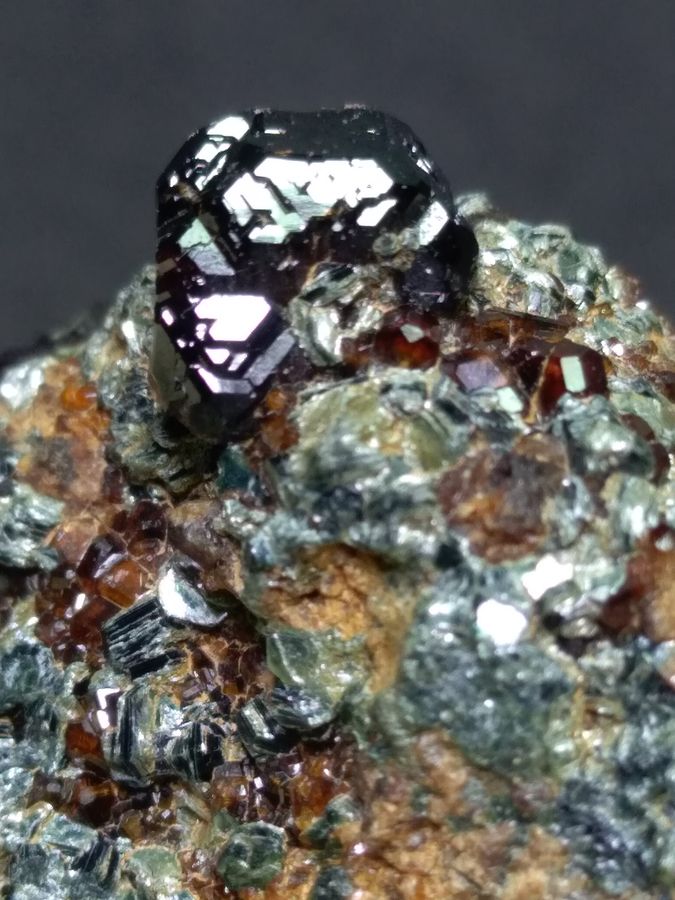
|
| Mineral: | Grossular (variety hessonite), Clinochlore |
| Locality: | | Faiallo Pass, Urbe, Savona Province, Liguria, Italy |  |
|
| Dimensions: | 48 x 36 mm |
| Description: |
| Back view. This face is perfectly parallel to the frontal one. |
|
| Viewed: |
22010 Time(s) |
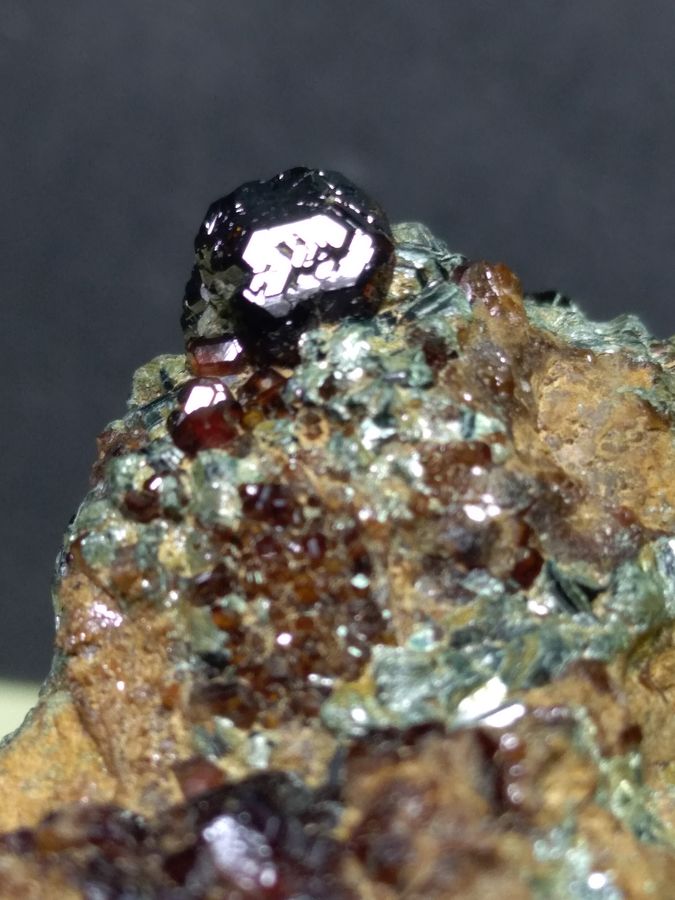
|
| Mineral: | Grossular (Var.: Hessonite), Clinochlore |
| Locality: | | Faiallo Pass, Urbe, Savona Province, Liguria, Italy |  |
|
| Dimensions: | 48 x 36 mm |
| Description: |
| A lateral face oriented 90° with the previous ones. |
|
| Viewed: |
22005 Time(s) |
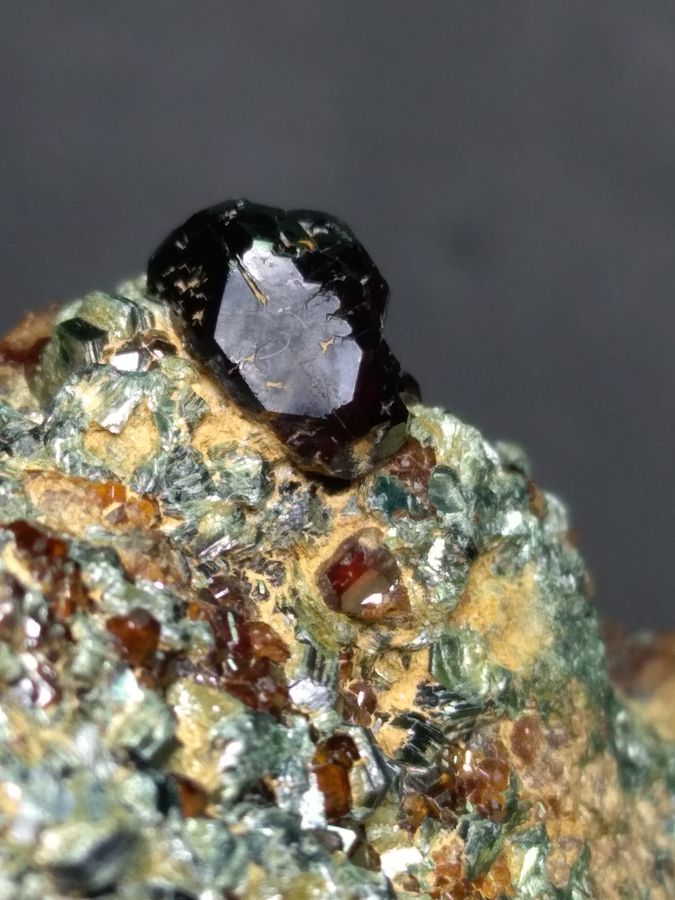
|
| Mineral: | Grossular (variety hessonite), Clinochlore |
| Locality: | | Faiallo Pass, Urbe, Savona Province, Liguria, Italy |  |
|
| Dimensions: | 48 x 36 mm |
| Description: |
| Zenithal view. A different view of the cubic dominance and a cubic face as confirmation. |
|
| Viewed: |
22016 Time(s) |
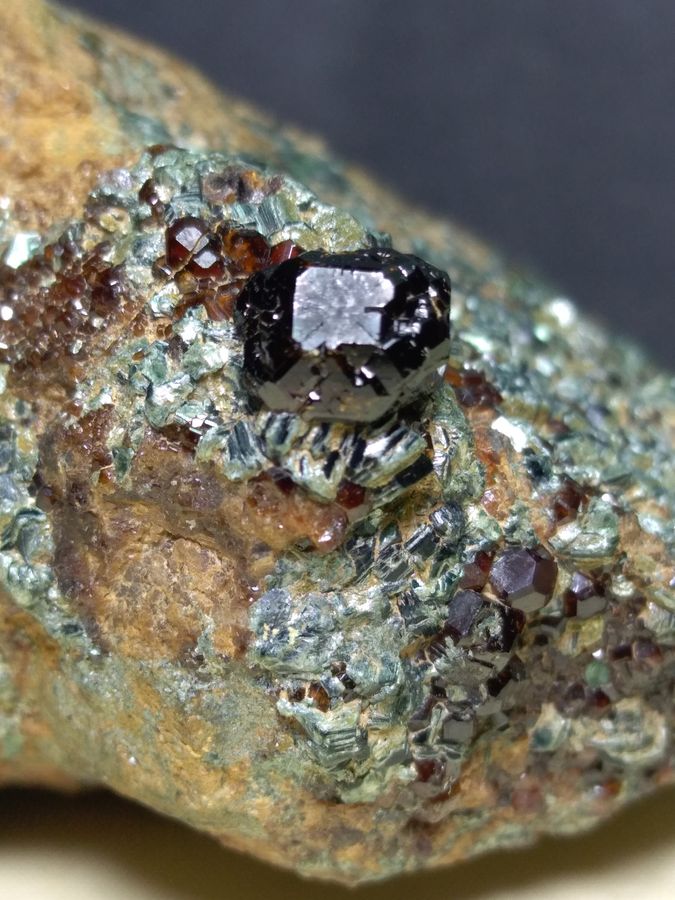
|
| Mineral: | Grossular (variety hessonite), Clinochlore |
| Locality: | | Faiallo Pass, Urbe, Savona Province, Liguria, Italy |  |
|
| Dimensions: | 48 x 36 mm |
| Description: |
| Smaller crystals, some with suspected cubic faces. |
|
| Viewed: |
22017 Time(s) |
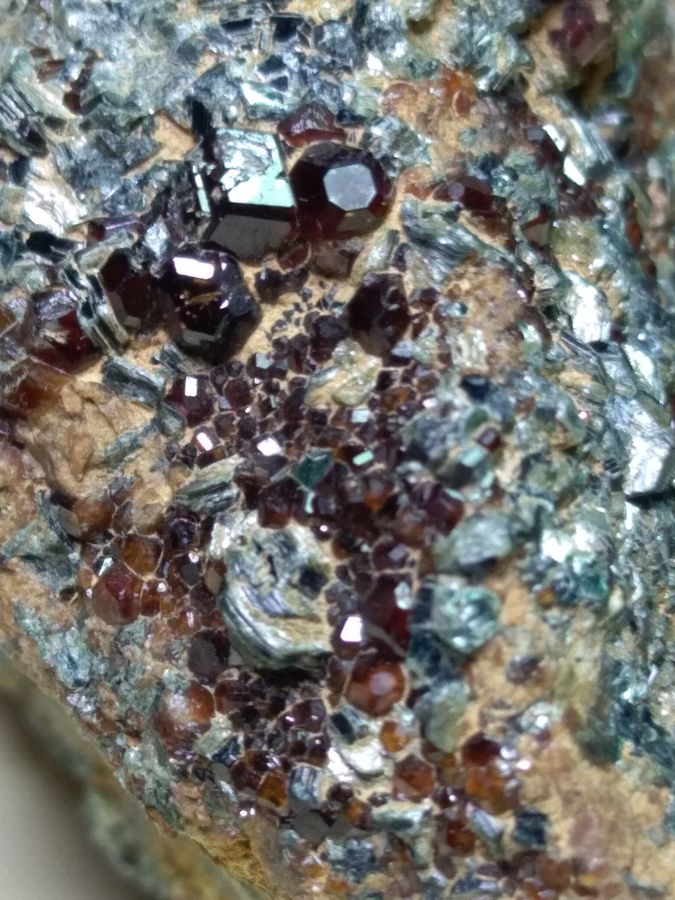
|
| Mineral: | Grossular (variety hessonite), Clinochlore |
| Locality: | | Faiallo Pass, Urbe, Savona Province, Liguria, Italy |  |
|
| Dimensions: | 48 x 36 mm |
| Description: |
| Different side. Small crystals with suspected cubic faces. |
|
| Viewed: |
22008 Time(s) |
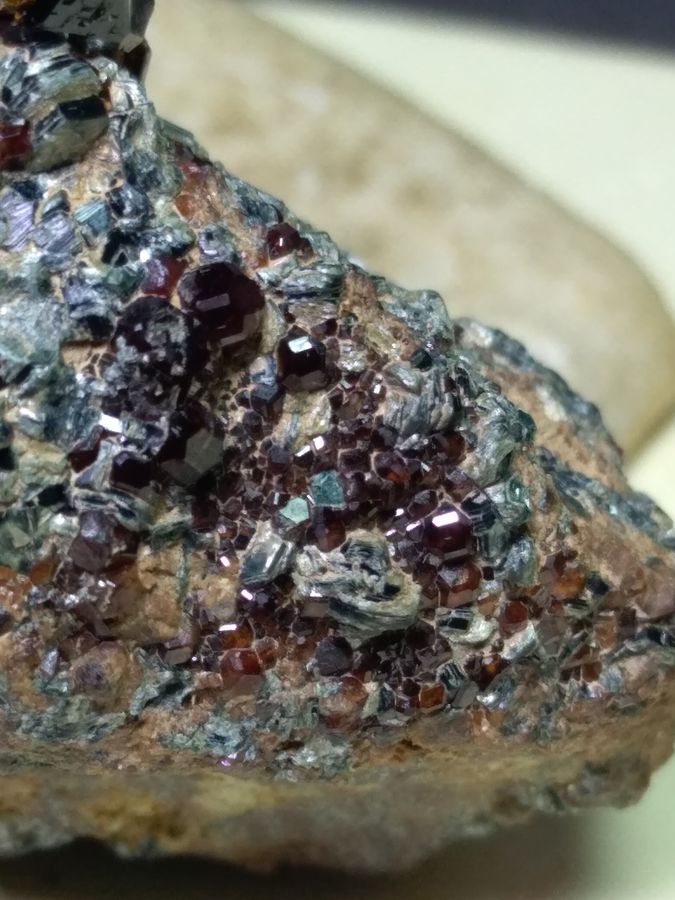
|
|
|
| Back to top |
|
 |
|





